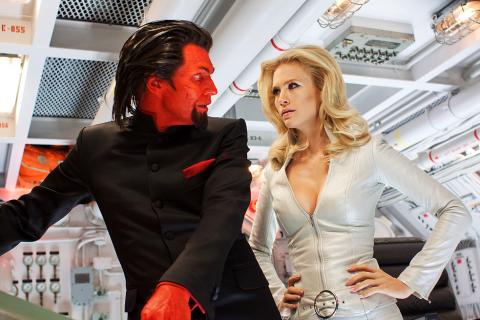The first thing that should be said about X-Men: First Class is that it has successfully revived the X-Men franchise with an injection of energy, imagination and a return to the golden age of the Marvel comic book. It has put the overwrought and convoluted narratives of X-Men: The Last Stand (2006) and spin-off movie X-Men Origins: Wolverine (2009) behind it and found sustenance in telling a good, old-fashioned story.
X-Men: First Class takes us back to a sequence seen as a flashback in the first X-Men film that hinted at Magneto’s background as a victim of Nazi experimentation, thus explaining his jaundiced view of humanity. The earlier films also hinted at a close relationship between Magneto and his rival Charles Xavier, but left its exact nature vague. All this is explained in exhaustive detail in this latest outing for the X-Men.
Patrick Stewart and Ian McKellen have been replaced as Xavier and Magneto by James McAvoy and Michael Fassbender, who do a remarkable job in building up a fragile relationship between men sympathetic to each other personally, but with utterly irreconcilable ideas about the world and their place in it. Fassbender is the more complex and interesting character, and his magnetism provides one of the most powerful driving forces of the film.

Photo courtesy of 20th Century Fox
The film opens in the aftermath of World War II with various Nazi nasties safely ensconced in Latin America. Erik Lehnsherr, who will later morph into Magneto, is on a hunt for those who killed his family and his people in the concentration camps. He is the first among many characters the film hurries to introduce in a breakneck half hour at the beginning of the film, with the camera restlessly jumping around the world picking up threads in preparation for the story proper. Such a wave of introductions can bog a film down even before it gets going, and it is to director Matthew Vaughn’s credit that he carries the audience through, alternating action and character explication in
deft strokes.
The other main character who is developed in X-Men: First Class is Mystique, the blue, semi-reptilian shape-shifter originally played by Rebecca Romijn. Now, in the hands of Jennifer Lawrence (who made her stunning cinematic debut in Winter’s Bone, released here earlier this year), Mystique develops into a more complex and nuanced character whose special ability to appear as anybody she wants becomes part of an interesting twist in the dialogue about identity and conformity that runs through the film and gives it a smidgen of intellectual credibility.

Photo courtesy of 20th Century Fox
The main action of the movie is set against the backdrop of the Cold War and the Cuban Missile Crisis, which, in an amusing conceit, is portrayed as a battle between superhuman forces in which the US and USSR governments are merely pawns. The arch villain, rather than being the Soviets, is in fact Sebastian Shaw (Kevin Bacon), an ex-Nazi doctor who aims at the destruction of the human race. Shaw was that same doctor who experimented on the young Magneto and led him to the discovery of his powers. It all ties up rather neatly.
Unfortunately, there is also a lot of narrative mess littered over the film’s 132 minutes, with a whole range of characters who are never fully explained. There are Shaw’s two lieutenants, who are barely named, and whose special powers are never made particularly clear. A second round of introductions to a group of minor characters who accompany Xavier and Magneto are more detailed, but serve primarily as a way of setting the stage for the final set piece battle. All this seems a little ragged, but the central narrative is just about powerful enough to barrel through this chaos.
X-Men: First Class is not shy about reveling in its vintage comic book style. Some effects — such as Magneto pulling a submarine out from beneath the waves — are clunky in a way that is of a piece with the old-school vibe of the movie, and are fun for that very reason. For a superhero movie, the action sequences are remarkably restrained, which works to the film’s advantage, and it was a relief not to have to sit through a reprise of the interminable and overblown battle sequences of Last Stand or Wolverine. While none of the action is likely to leave audiences slack-jawed with amazement, at least you don’t leave the cinema feeling you have just been beaten about the head with a brick.

Photo courtesy of 20th Century Fox
Sex is also treated with restraint, even though there is no shortage of eye candy, most notably in the form of January Jones (who plays Emma Frost). With her wardrobe of tight-fitting, low-cut white leather body suits, thigh-high boots and jeweled bustiers, Jones looks like a Sean Connery-era Bond girl.
There is plenty to enjoy in X-Men: First Class, despite the fact it is uneven, overlong, and often gets weighed down with wooden, expository dialogue. On the plus side, it does a fine job in dovetailing its story into the main X-Men franchise both in terms of character and narrative and has some excellent central performances, but most of all it is an exciting story peopled with an array of extravagant characters.

Wooden houses wedged between concrete, crumbling brick facades with roofs gaping to the sky, and tiled art deco buildings down narrow alleyways: Taichung Central District’s (中區) aging architecture reveals both the allure and reality of the old downtown. From Indigenous settlement to capital under Qing Dynasty rule through to Japanese colonization, Taichung’s Central District holds a long and layered history. The bygone beauty of its streets once earned it the nickname “Little Kyoto.” Since the late eighties, however, the shifting of economic and government centers westward signaled a gradual decline in the area’s evolving fortunes. With the regeneration of the once

Even by the standards of Ukraine’s International Legion, which comprises volunteers from over 55 countries, Han has an unusual backstory. Born in Taichung, he grew up in Costa Rica — then one of Taiwan’s diplomatic allies — where a relative worked for the embassy. After attending an American international high school in San Jose, Costa Rica’s capital, Han — who prefers to use only his given name for OPSEC (operations security) reasons — moved to the US in his teens. He attended Penn State University before returning to Taiwan to work in the semiconductor industry in Kaohsiung, where he

In February of this year the Taipei Times reported on the visit of Lienchiang County Commissioner Wang Chung-ming (王忠銘) of the Chinese Nationalist Party (KMT) and a delegation to a lantern festival in Fuzhou’s Mawei District in Fujian Province. “Today, Mawei and Matsu jointly marked the lantern festival,” Wang was quoted as saying, adding that both sides “being of one people,” is a cause for joy. Wang was passing around a common claim of officials of the People’s Republic of China (PRC) and the PRC’s allies and supporters in Taiwan — KMT and the Taiwan People’s Party — and elsewhere: Taiwan and

Perched on Thailand’s border with Myanmar, Arunothai is a dusty crossroads town, a nowheresville that could be the setting of some Southeast Asian spaghetti Western. Its main street is the final, dead-end section of the two-lane highway from Chiang Mai, Thailand’s second largest city 120kms south, and the heart of the kingdom’s mountainous north. At the town boundary, a Chinese-style arch capped with dragons also bears Thai script declaring fealty to Bangkok’s royal family: “Long live the King!” Further on, Chinese lanterns line the main street, and on the hillsides, courtyard homes sit among warrens of narrow, winding alleyways and